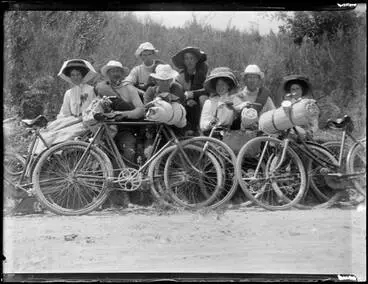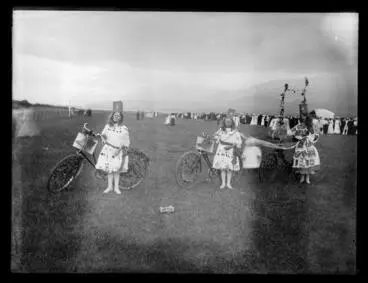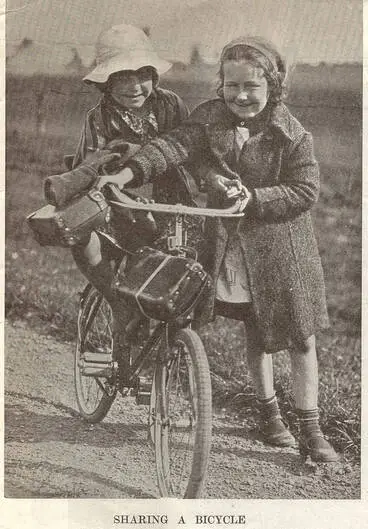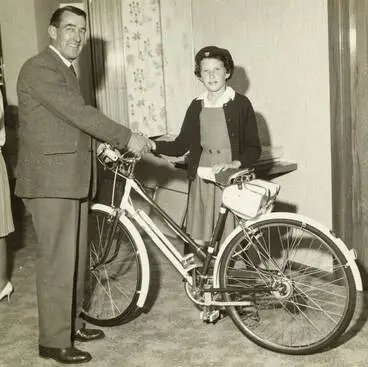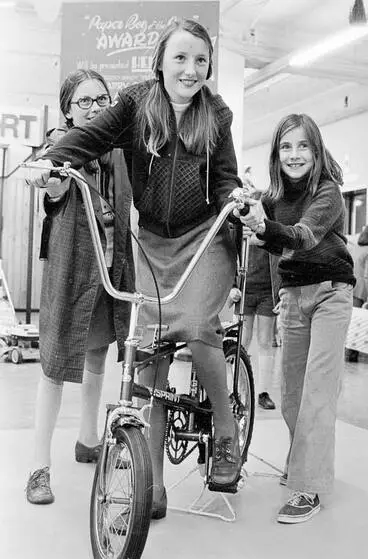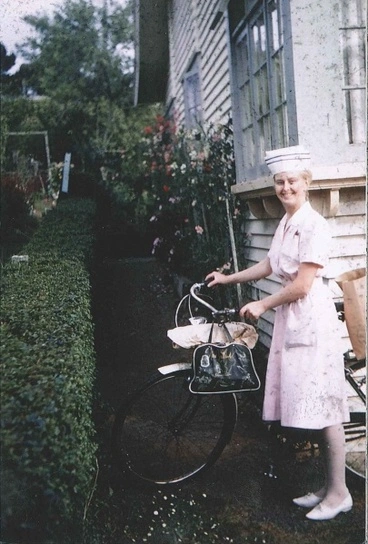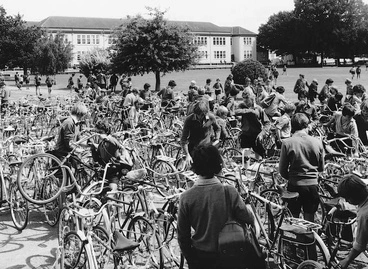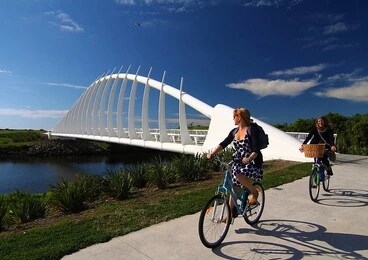The bicycle and women’s suffrage
A DigitalNZ Story by National Library Services to Schools
A new type of bicycle appeared in the late 1880s. The safety bicycle was relatively small, comfortable to ride, and played a role in women’s emancipation.
These resources and text relate to the bicycle and women’s suffrage and the wider social impact increased mobility offered females from the late 1880s. They have been sourced and collated from DigitalNZ and other websites.
Griffiths family, including four on bicycles, probably Wanganui district
Alexander Turnbull Library
Background
In the late 1880s, the safety bicycle arrived in New Zealand. They had tires filled with air and were much more comfortable to ride than previous bikes. They were popular with women as well as men.
The first all-women cycling club in Australasia was the Atalanta Cycle Club, started in Christchurch in 1892. Suffrage campaigner Kate Sheppard and dress reformer Alice Burn were members of the club, which organised picnics, day trips and longer tours. Women’s clubs became synonymous with the emancipation they sought.
Source: Jamie Mackay, 'Bicycles', Te Ara - the Encyclopedia of New Zealand, http://www.TeAra.govt.nz/en/bicycles (accessed 9 August 2018)
Safety bicycles
Manatū Taonga, the Ministry for Culture and Heritage
Cleaning bicycles
Auckland Libraries
Spencer family and friends on a bicycle outing
Auckland Libraries
Context
The development of the modern bicycle in the 1880s promised women more freedom to travel without the need for a male chaperone. Cycling opened up new social worlds, but it wasn’t without its dangers. Women cyclists were sometimes jeered at, abused and even pushed from their bicycles. Members of the club sometimes cycled with brothers or husbands to protect them against such attacks.
On the night of 18 August 1892, cycling enthusiasts gathered in Christchurch to discuss the formation of a cycling club for women.
From the first meeting, the topic of uniform was debated. Women’s clothing of the 1890s was cumbersome, with long skirts and corsets. For cycling, women had a choice of divided cycling skirts or ‘dress reform’ attire such as bloomers and knickerbockers. Dress reform was often associated (in an unflattering manner) with the feminist movement. In September 1892 the Atalanta Club decided that members could choose their own clothing, so long as the club colours were prominent. A year later, however, it was resolved that the uniform should be a plain skirt with a cream blouse, with colours navy and blue.
Source: 'First women's cycling club in Australasia formed', https://nzhistory.govt.nz/page/first-womens-cycling-club-australasia-formed, updated 8-Jun-2018
Decorated bicycles
Nelson Provincial Museum
Bella Bathurst: bicycles
Radio New Zealand
Woman's bicycle, Christchurch
Alexander Turnbull Library
Fertile questions
How is it activism to ride a bicycle?
How do new technologies influence social changes?
How do bicycles help us?
Is it safer to ride a bicycle today than it was 100 years ago?
What is your question?
Quick facts
- “Wear an old dress, easy shoes and gloves, and a hat that will stay on under any conditions.” That was the advice from Bicycling for Ladies published in 1896 on learning how to ride a bike.
- A lady scorcher was a fast female bicycle rider who rode at recklessly high speeds, the equivalent of a girl-racer today.
- In 1894, 24-year-old American mother of three Annie Londonderry became the first woman to cycle around the world. She completed the trip in 15 months.
- In 1896, prominent American women's rights activist Susan B. Anthony stated that “The bicycle has done more for the emancipation of women than anything else in the world.”
- In 1924, the Christchurch city council's motor inspector estimated that there were 40,000 cyclists in the city, half the population at the time.
- In Christchurch by 1898 it was claimed there was hardly a woman who didn’t ride a bike or was learning to ride one.
- Early women cyclists in New Zealand were sometimes insulted by people when cycling. They also had stones and food thrown at them.
Sharing a bicycle
Auckland Libraries
Prize bicycle, Ōtāhuhu, 1963
Auckland Libraries
Girls with Sprint bicycle
Manatū Taonga, the Ministry for Culture and Heritage
OTHER RESOURCES
A social history of women and cycling in late-nineteenth-century New Zealand
Cycles past — bicycles in New Zealand's history.
Cyclist survey— women cyclists trailing far behind men.
Frocks on bikes— a unique cycle organisation that aims to get more women on bikes.
How cycling helped Kiwi women win the vote — the humble bicycle empowered women in New Zealand.
New Zealand women with bicycles — a set of photographs of New Zealand women with their bicycles.
Peddling to freedom — 19th-century cycling dress for women.
Riding for Change — a short video on the reaction of some 19th century men to women riding the new safety bicycle.
Wandering hogs of the road— dangerous roads in 1919.
Anne with bicycle
The New Zealand Nursing Education and Research Foundation
Bicycles at school
Manatū Taonga, the Ministry for Culture and Heritage
BICYCLE BARGAINS. (Star, 19 December 1903)
National Library of New Zealand
Over The River
Manatū Taonga, the Ministry for Culture and Heritage
CYCLING FOR WOMEN. (West Coast Times, 18 January 1897)
National Library of New Zealand
Woman with a bicycle
Museum of New Zealand Te Papa Tongarewa
This story was compiled and curated by Te Puna Mātauranga o Aotearoa | National Library of New Zealand, Services to Schools staff, in 2019.


